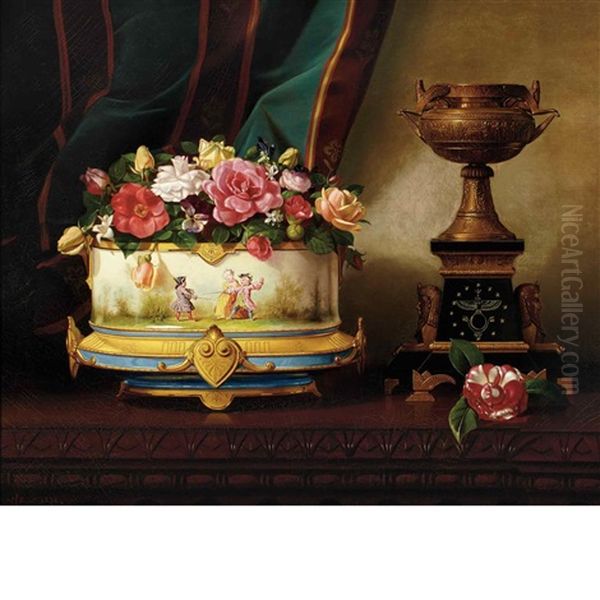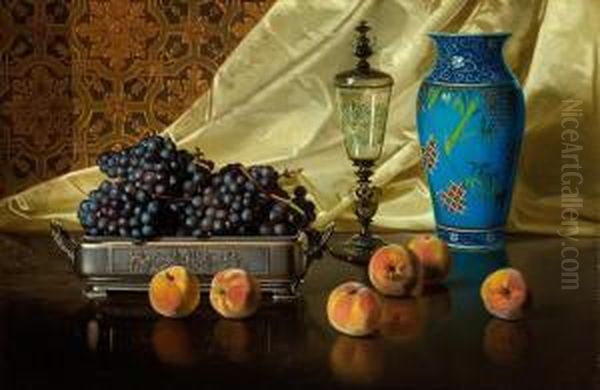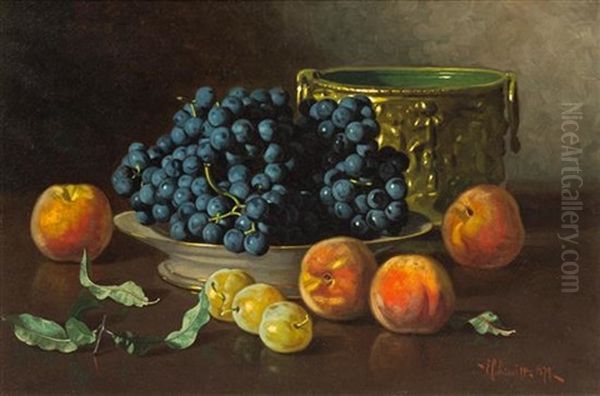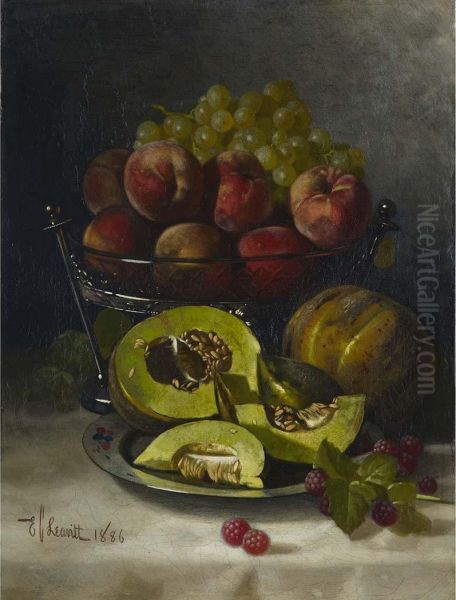Edward Chalmers Leavitt stands as a significant figure in late nineteenth-century American art, particularly celebrated for his contributions to the genre of still life painting. Born in Providence, Rhode Island, in 1842, Leavitt became one of his home city's most prominent artists, carving out a distinct niche with his detailed and richly textured depictions of tabletop arrangements. His work found considerable favor among the burgeoning middle class of the era, who appreciated his ability to capture the beauty and luxury of everyday objects. Leavitt passed away in 1904, leaving behind a prolific body of work that continues to attract interest.
Early Life and Artistic Formation
Details surrounding Edward Chalmers Leavitt's early life and formal artistic training remain somewhat scarce in historical records. It is known that he was active as a painter in his native Providence from a relatively young age. The city itself was developing its own cultural identity, fostering an environment where artistic pursuits could take root. While specific mentors or art schools he may have attended are not clearly documented in the provided sources, his later proficiency suggests a dedicated period of study and practice, whether through formal instruction or rigorous self-teaching, possibly supplemented by interactions with other local artists.
His early artistic development was briefly interrupted by national events. The American Civil War (1861-1865) called many young men into service, and Leavitt was among them. He joined the United States Navy, serving as a crewman aboard the U.S.S. Galena between 1862 and 1863. This vessel saw action during the conflict, providing Leavitt with experiences far removed from the artist's studio. Interestingly, even amidst his naval duties, Leavitt reportedly continued to hone his artistic skills, suggesting a deep-seated commitment to his craft that persisted even under challenging circumstances. Specific anecdotes or detailed accounts of his duties or notable events during his service are not readily available.
The Signature Style: Realism and Rich Textures

Upon returning to civilian life and dedicating himself fully to his art, Leavitt focused intently on still life painting. This genre, with roots stretching back to European masters and earlier American practitioners like Raphaelle Peale and James Peale, experienced a resurgence of popularity in the United States during the latter half of the nineteenth century. Leavitt's approach fit well within the prevailing taste for realism, yet he developed a distinctive style characterized by a remarkable attention to texture and detail.
His canvases typically feature carefully arranged tabletop compositions. Luscious fruits, such as grapes, peaches, and pears, often spill from baskets or rest in ornate silver dishes. Flowers, rendered with botanical accuracy and vibrant color, burst from elegant vases or cachepots. Complementing these natural elements were often man-made objects that spoke of refinement and cultivated taste: antique curios, gleaming silverware, glass decanters, and bottles of wine. These elements combined to create scenes of domestic luxury and abundance.
A hallmark of Leavitt's technique was his handling of oil paint, often described as achieving a unique and palpable texture. He skillfully rendered the soft bloom on a grape, the delicate petals of a rose, the cool sheen of metal, and the reflective surface of glass. This tactile quality brought his subjects to life, making them visually engaging and appealing. His style catered perfectly to the aesthetic preferences of the Gilded Age, an era marked by economic growth and an increasing desire among the middle and upper-middle classes to adorn their homes with art that reflected prosperity and sophistication.
Subjects of Choice: Celebrating the Domestic Sphere
Leavitt's choice of subject matter was consistent throughout his career. He rarely strayed from the domain of still life, finding endless inspiration in the interplay of light, color, form, and texture within his arranged compositions. Flowers were a recurring motif, depicted in various states from fresh buds to full bloom, often presented in decorative containers popular during the Victorian era. His fruit pieces captured the ripeness and sensual appeal of nature's bounty, arranged to maximize their visual appeal.

The inclusion of antiques and 'vintage' decorative items (objets d'art) in his paintings added another layer of interest. These objects not only served as compositional elements but also evoked a sense of history, connoisseurship, and worldly possession. They reflected the collecting habits and decorative tastes of his clientele. By focusing on these themes, Leavitt tapped into the aspirations and values of his audience, providing them with art that was both beautiful and resonant with their domestic lives. His work celebrated the material comforts and aesthetic sensibilities that were becoming increasingly accessible to a wider segment of American society.
Prolific Output and Notable Works
Edward Chalmers Leavitt was an exceptionally prolific artist, credited with creating thousands of paintings during his career. This immense output speaks to his dedication and the steady demand for his work. While many of his paintings reside in private collections, several key examples highlight his skill and typical subject matter.
One frequently cited work is Still Life of Flowers in a Cachepot, dated 1872. This piece exemplifies his early mastery of floral painting, showcasing his ability to render intricate details and create a balanced, pleasing composition. Another significant painting is Still Life with Peaches and Grapes in a Silver Dish from 1881, demonstrating his skill in capturing the textures of fruit and the reflective qualities of silverware.
Perhaps one of his best-known later works is Still Life with Grapes, Pears and a Bottle of Wine in a Basket, painted in 1895. This painting, held in the collection of the Field Museum in Chicago, encapsulates many characteristic elements of his style: the abundant arrangement of fruit, the inclusion of a wine bottle suggesting conviviality, and the rustic texture of the basket, all rendered with his signature realism and attention to detail. These works, among many others, solidified his reputation as a master of the still life genre.
Exhibitions and Recognition
Leavitt's work gained recognition beyond his local Providence circle. He frequently exhibited his paintings, most notably at the prestigious National Academy of Design in New York City during the 1870s and 1880s. The National Academy was a crucial venue for American artists seeking national exposure and critical validation. Exhibiting there placed Leavitt alongside many of the most prominent artists of his time, including landscape painters of the Hudson River School like Albert Bierstadt and Frederic Edwin Church, genre painters, and fellow still life specialists like George Henry Hall.

His participation in these exhibitions indicates his standing within the broader American art community. His paintings were reportedly well-received, praised for their technical skill and appealing subject matter. The popularity of his work was further amplified through the circulation of reproductions and museum copies, making his images accessible to an even wider audience and cementing his name recognition. This exposure contributed significantly to his status as one of New England's foremost still life painters during the late nineteenth century.
Contemporaries and Artistic Milieu
Leavitt practiced his art during a vibrant period in American art history. While he specialized in still life, the broader artistic landscape included diverse movements and prominent figures. The influence of the Hudson River School was waning, but landscape painting remained popular. Genre painting, depicting scenes of everyday life, was practiced by artists like Eastman Johnson and Winslow Homer. Portraiture continued to be a major field, soon to be dominated by figures like John Singer Sargent. Meanwhile, American artists were increasingly engaging with European trends, particularly French Impressionism, championed by artists like Mary Cassatt and Childe Hassam.
Within the realm of still life, Leavitt had notable contemporaries. Martin Johnson Heade, also associated with Providence for a time, was a highly talented artist known for his unique combination of still life elements (especially flowers like orchids and passionflowers) with landscape and sometimes hummingbirds. Sources suggest that Leavitt may have interacted or even collaborated with Heade at some point, an association that likely proved mutually stimulating, further refining Leavitt's skills.
Other American still life painters active during or overlapping with Leavitt's career include Severin Roesen, known for his incredibly abundant and detailed Victorian fruit and flower compositions, often reminiscent of Dutch Golden Age painting. The trompe-l'oeil ("fool the eye") school, featuring hyper-realistic depictions of objects, gained prominence through artists like William Michael Harnett and John F. Peto. While Leavitt's style was realistic, it generally maintained a more painterly quality compared to the illusionism of Harnett or Peto. Later artists like Emil Carlsen would continue the still life tradition but often with a softer, more tonal or impressionistic approach. Leavitt's work sits firmly within the detailed, realistic tradition popular in the mid-to-late Victorian era.
Later Career, Teaching, and Legacy
In his later career, Edward Chalmers Leavitt remained a central figure in the Providence art scene. He became actively involved with the Providence Art Club, an important institution founded in 1880 to promote art and support local artists. His participation underscored his commitment to the artistic community of his hometown.

Furthermore, unlike the earlier indication of scarce information on teaching, some sources credit Leavitt with having taught or mentored numerous Rhode Island artists. This suggests he played an active role in nurturing the next generation of talent in the region, sharing his expertise in still life technique and composition. His influence thus extended beyond his own prolific output to shaping the skills of others within his community.
Edward Chalmers Leavitt's legacy rests on his mastery of still life painting and his significant contribution to the genre in late nineteenth-century America. He successfully captured the aesthetic sensibilities of his time, creating works that were both technically accomplished and highly desirable to his patrons. His focus on the beauty of flowers, fruit, and decorative objects, rendered with a distinctive textural realism, secured his place as a leading painter in New England. Though perhaps overshadowed in broader art historical narratives by artists associated with more avant-garde movements, Leavitt remains an important representative of the enduring appeal and skillful practice of still life painting in American art history. His numerous works continue to be appreciated for their charm, detail, and reflection of Victorian era tastes.